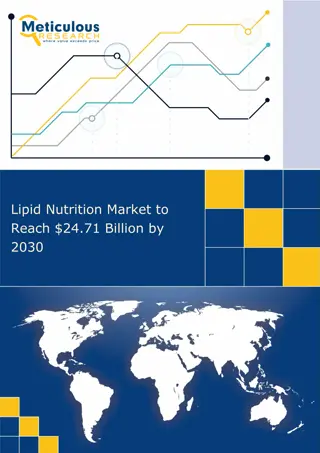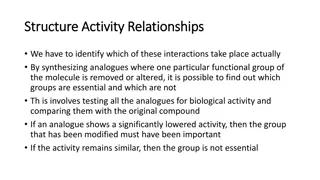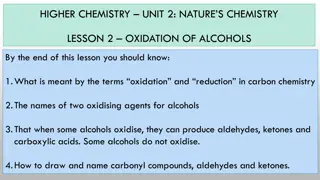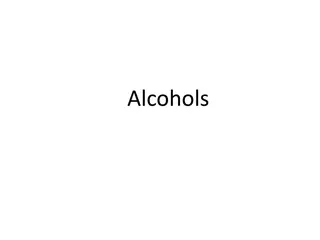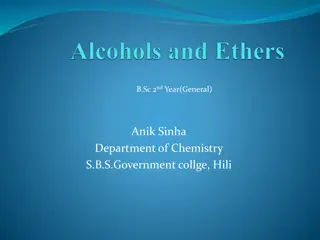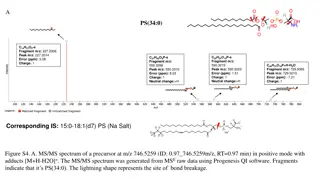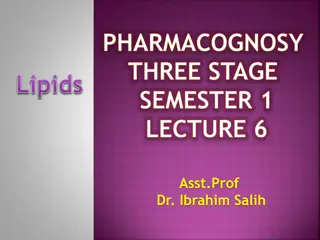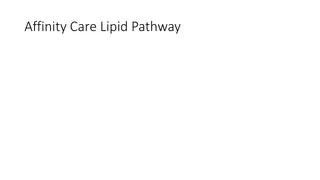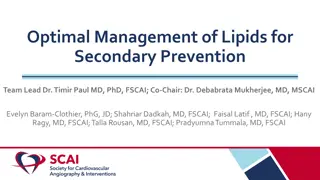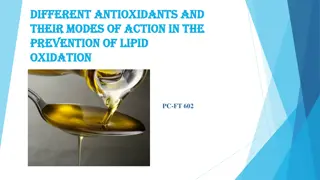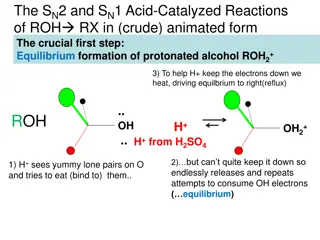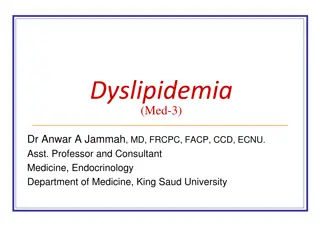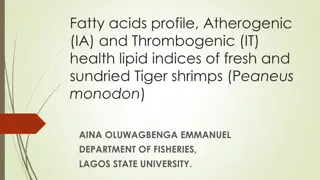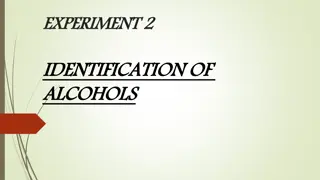Exploring Alcohols in Lipid Structures and Their Importance
Delve into the world of derived lipids alcohols, such as glycerol, sphingosine, and cholesterol, which play vital roles in various forms of lipids. Learn about the classification of alcohols involved in lipid structures and their significance as derived lipids. Discover how glycerol, a polyol, acts as a backbone for glycerol-based lipids like triacylglycerol and glycerophospholipids. Explore the sources of glycerol in the human body, specifically its transformation from glucose, and its utilization in biosynthesis of lipids.
Download Presentation

Please find below an Image/Link to download the presentation.
The content on the website is provided AS IS for your information and personal use only. It may not be sold, licensed, or shared on other websites without obtaining consent from the author. Download presentation by click this link. If you encounter any issues during the download, it is possible that the publisher has removed the file from their server.
E N D
Presentation Transcript
Study Of Derived Lipids Alcohols
Alcohols Involved In Lipid Structures
3 Alcohols Involved In Various Forms Of Lipids 1. Glycerol (C3-Trihydric Alcohol) 2. Sphingol/Sphingosine (C18-Dihydric Alcohol) 3. Cholesterol (C27-Monohydric Alcohol)
Alcohols Of Lipids Are Classified As Derived Lipids
Glycerol is a Derived Lipid Obtained from Hydrolysis of Simple and Compound Lipids
Glycerol/ Glycerin Glycerol [C3 ]is a POLYOL Glycerol is chemically Trihydric Alcohol (3 OH groups) Glycerol has potency to interact with 3 same or different Fatty acids .
Glycerol is a backbone of Glycerol based Lipids viz: Triacylglycerol Glycerophospholipids
Glycerol Sources To Human Body Endogenous and Exogenous Sources Glycerol Glucose
Source Of Glycerol To Human body Glucose is responsible for biosynthesis of Glycerol in human body Glucose transforms to Glyceraldehyde, Glyceraldehyde on reduction forms Glycerol.
Glycerol formed is then used for Biosynthesis of Glycerol based Lipids. Glycerol released from hydrolysis of Glycerol based Lipids is transformed to Glucose.
Sphingosine is a derived Lipid. Obtained from Hydrolysis of Sphingolipids
Sphingosine is a C18, complex Dihydric, Amino alcohol. Sphingosine is biosynthesized in human body using amino acid Serine. Serine provides NH2 group of Sphingosine.
Sphingosine forms Sphingolipids /Compound Lipids with Alcohol Sphingol Examples of Sphingolipids: Sphingophospholipids Sphingoglycolipids
What Is a Ceramide? A Fatty acid linked to an amino group of Sphingosine With an amide linkage form a Ceramide.
Ceramide if linked to Phosphate and Nitrogenous groups forms Sphingophospholipids. Ceramide linked to Carbohydrate moieties form Sphingoglycolipids.
Common Sterol And Steroids Vitamin D3 (cholecalciferol) Cholesterol (a sterol) Testosterone (a steroid hormone) Stigmasterol (a phytosterol)
Sterols are chemically complex, organic monohydric Alcohols. Sterols has cyclic ring structures
Sterols have a parent ring Cyclo Pentano Perhydro Phenantherene (CPPP) nucleus.
Examples Of Sterols Cholesterol (Animal Sterol) 7 Dehydrocholesterol( Provitamin D) Coprosterol (Excretory form Cholesterol) Ergosterol(Plant Sterol) Sitosterol(Plant Sterol)
Cholesterol Most abundant Sterol of Human body
Cholesterol Cholesterol is an Animal Sterol . Cholesterol means Solid Alcohol as it was first obtained from gall stones of bile. Cholesterol is excreted via bile hence richly composed in bile ,Gall stones.
Cholesterol Is A Derived Lipid
Cholesterol is classified as Derived Lipid. It is derived from hydrolysis of Cholesterol Ester (Human Body Wax).
Chemical Structures Of Cholesterol and Cholesterol Ester
Pentahydrophenantrene (Sterane)
Structure Of Cholesterol Cholesterol is complex,cyclic, unsaturated, monohydric Alcohol. Molecular formula is C27H45OH
Cholesterol has parent nucleus as Cyclo Pentano Per hydro Phenantherene ring system(CPPP). The structure of CPPP has four fused cyclic rings (A,B,C and D)
Hexane ring A,B,C is a Phenatrene nucleus. D ring is Cyclopentane ring.
The Structure of Cholesterol Possess: 1. Hydroxyl group (-OH) at C3. 2. Double bond between C5 and C6. 3. 5 Methyl (-CH3) groups. 4. 8 Carbon side chain linked to C17 of the structure.
Forms Of Cholesterol In Human Body Cholesterol exists in two forms: Free Cholesterol - 30% (Amphipathic form) Cholesterol Ester - 70% (Non polar form)
Properties Of Cholesterol Cholesterol is white or pale yellowish, crystalline ,odorless compound. Insoluble in water and soluble in organic solvents like Ether and Chloroform.
Crystals of Cholesterol Rhombic plates withNotched edges.
Qualitative Tests For Cholesterol detection are: Liebermann Burchard Reaction Salkowski Reaction Zak s Reaction
Sources Of Cholesterol To Human Body
Exogenous Sources of Cholesterol: Animal Origin Food Items Endogenous Source Of Cholesterol: Obtained In well fed condition from Excess Glucose
Dietary Sources Of Cholesterol Cholesterol is exclusively present in animal foods.
The dietary rich sources of Cholesterol animal origin foods like: Egg Yolk Meat Milk Butter Ghee Cream
Remember Cholesterol is absent in plant origin food items.
Endogenous Source Of Cholesterol Cholesterol Biosynthesized in human body from Free Excess Glucose in Liver.
Transportation Of Cholesterol Cholesterol in blood is transported by Lipoproteins: Chylomicrons ( Dietary origin) LDL (From Hepatocytes to Extra hepatocytes) HDL (From Extra hepatocytes to Hepatocytes)
Occurrence and Distribution Of Cholesterol in the Body
70 % of Cholesterol associated with cellular components 30 % of Cholesterol is in the Blood.


